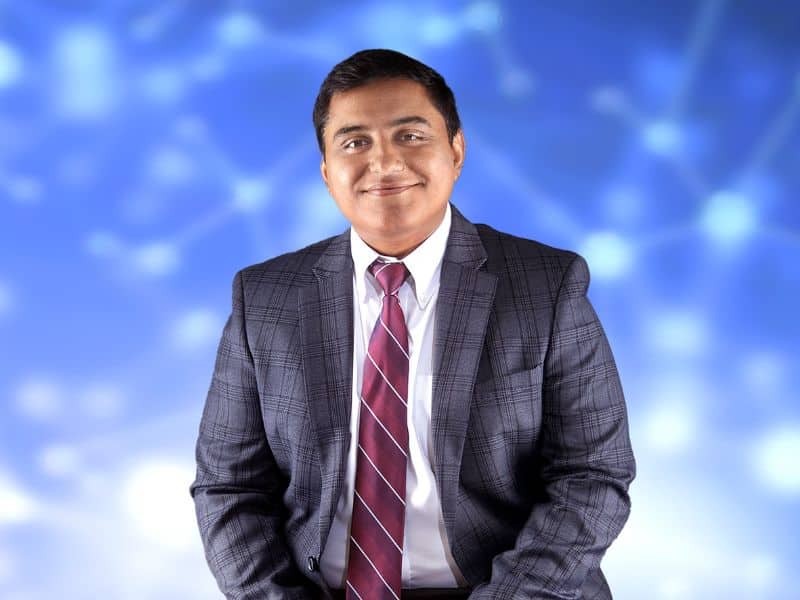AI DEEPFAKES
Whose truth are you looking at?
Nitin Agarwal, Ph.D., Maulden-Entergy Chair and Distinguished Professor of Information Science, Director, Collaboratorium for Social Media and Online Behavioral Studies (COSMOS), University of Arkansas at Little Rock
AFTER MONTHS OUT of the public eye following surgery, Kate, the Princess of Wales, appeared smilingly with her children in a photograph that was widely distributed by world news agencies. But soon people started questioning the picture: What’s up with her distorted looking hand against her cuff? Why are her fingers so fuzzy against her son’s sweater? Media outlets began questioning the photo they had distributed, and soon asked recipients not to continue publishing it.
Eventually, an expert on photo retouching was brought in, and he announced that the picture contained “numerous…manipulations easily visible.”
It turned out that this was just another example of innocent human vanity, of Kate’s doing a bit of understandable photo editing before releasing the picture. But the flap over the image underscored where we are today: With the increasing capabilities of Artificial Intelligence, what’s real and what’s not? Can anybody trust anything anymore?
We have been moving, imperceptibly, in this direction for years. Ever since the arrival of smartphones, we’ve all seen how images can be enhanced and improved. We can increase brightness, increase contrast, and make all sorts of touch-ups on our photos and videos. But that was the limit to these tools previously. Now, with the advent of AI in advanced models like adversarial neural networks or generative adversarial networks (GANs), these technologies have automated that process of image or video manipulation to the extent that they can even create new ones out of the blue.
Let’s say someone has an image of your face plus samples of your voice from your public appearances and speeches. Those speeches can be used to train the model to speak a new script, in your voice and with your inflections, and the video can be displayed on top of that newly created voice. It appears now like you have said those very words, which you have not. That is what deepfakes are. The trajectory of this evolution has gone from very basic image manipulation—enhancements, et cetera—to combining things from someone’s public voice, to even training the model to say new things in the same tonalities as that person would have spoken these words—all because there is enough data available. This being an election year, think of presidents or presidential candidates. So much public information from them is available that it’s possible to train these models quite effectively with very high accuracies.
Today, entire websites with text, images, and video are being produced using these AI tools. All that content generation by just the press of a button is accelerated by advanced graphical processing units (or GPU) chips. These technologies are quite affordable and readily available. Many industries are finding the usage of these capabilities irresistible. Just look at the stock of Intel and Nvidia, the two world- leading GPU manufacturing companies—it’s just skyrocketing. The downside, though, is that the automated production of low-trustworthy content has also become cheaper and more accessible.
So now the question is, how can we ever trust anything again? And what does that do to a society?
***
THE WAY TO solve that is to develop more media literacy and more critical thinking skills. We need to give society enough tools to detect these types of deepfakes. Even though they can be very sophisticated, they are still usually marked by small, perceptible mistakes. The human eye needs to become careful enough to notice that a person in a photo or video has six fingers, or their eyes are misaligned, or one ear is bigger or shorter or a different color, or has an earring unlike that in the other ear. This kind of perceptive skillset needs to be developed in our society, and fast.
A very good example of this took place recently in the Taiwanese elections. Because elections tend to be such big events, a lot of propaganda is thrown out there in hopes that it’ll stick. In Taiwan, we saw disinformation about counting fraud during the voting, but the society came together—social media influencers, fact-checking organizations, government accounts, regular citizens—and they were able to debunk that disinformation within a matter of 48 hours. The entire disinformation campaign was shown to be a sham, and the faith and trust in the democratic institutions—in the voting, in the ballot processes—were restored. And the society came out even stronger as a consequence.
You may say that our country is so much bigger and more diverse than Taiwan, and that’s true. But they also have strong divisions in their society. There’s a big faction of supporters of reunification with China, and another faction vehemently opposes reunification. So, while their country is smaller than ours, this does present a very interesting case of an entire society coming together to debunk political disinformation within an incredible 48 hours.
The key takeaway from that example is that the Taiwanese people were already primed to be aware that disinformation, whether political or cultural, was going to happen in their society and that they needed to regard any such claims with a critical eye. They were also aware of how to detect such false or untrustworthy information or sources. It has to start from that level—first, acute awareness of the problem, and then education on how to judge such mis- or disinformation.
The Internet acts as a force multiplier. Once a deepfake is out there, it gets shared and replicated thousands or maybe hundreds of thousands of times, depending on the size of the population that is spreading it. So, besides the efforts of society’s stalwarts—public figures and leaders with influence—we need automated or computational tools to help determine what is true and what is not. In other words, we need AI to fight fire with fire. While AI poses challenges, such as generation of deepfakes, it also provides opportunities to mitigate cognitive threats. AI and large language models (LLMs) have undoubtedly exacerbated the problem of fake content by automating its creation and dissemination, whether it is deepfakes, fake blog posts, tweets, articles, messages, and the like spread by bots (computer programs). However, the modern AI revolution affords advanced content and network analysis capabilities at web-scale to detect and diffuse such cognitive threats.
Even years ago, at the start of my research in social media, we had the content quality issue. Anyone can post anything, and how does one fact-check that? Yet, it is still text for which we have advanced computational content analysis techniques. The deepfakes (images and videos), which my research team also tracks, get shared on the Internet with lightning-fast speed. So, while this developing AI is being misused or abused to create all these deepfakes, we must simultaneously use AI capabilities to detect how they’ve been created and whether a particular image is a true image versus generated, a fake, or a deepfake. We can measure how much the deepfake has been circulating, identify who has shared it, who has engaged with it, and where focused intervention efforts (e.g., inoculation, education) are needed, particularly in those specific groups that are exposed or infected by the malicious content. Such a contagion phenomenon can be modeled using epidemiological theories. So, theoretical grounding plus computational methodology provides a robust solution to this problem.
At COSMOS Research Center, we are developing research-driven solutions validated by real-world data. We are transitioning such capabilities into the hands of policymakers, our warfighters, and the public by leveraging our past work on combating socio-cognitive threats and global collaborations with support from an array of federal funding agencies to the tune of over $25 million. I encourage you to visit https://cosmos.ualr.edu to learn more about these efforts.
I believe that in some ways these deepfakes provide an opportunity for our societies to come together, be stronger, and become more resilient in fighting such cognitive threats. But it is, and will continue to be, a cat-and-mouse game. So, as adversarial behaviors become increasingly sophisticated, the good guys must also catch up to fight the bad guys. Ultimately, that “Oh, I got something explosive here” instinct combined with that kneejerk urge to share or forward deepfakes needs to be controlled. Again, that comes with critical thinking. We need to think: If something is too bizarre or scandalous, let me check it before I forward it to my hundreds of contacts on WhatsApp or whatever platform we use.
Disclaimer: Any opinions, findings, and conclusions or recommendations expressed in this material are those of the author and do not necessarily reflect the views of the funding organizations. The author gratefully acknowledges the support.
Dr. Nitin Agarwal has published 11 books and over 300 articles on social media and influence campaigns in top-tier peer-reviewed forums, including NATO’s Defense StratCom Journal, US Army University Press, Canadian Special Operation Forces Command’s Future Conflict journal, and Baltic Security, among others, with several best paper awards and nominations. He leads several projects on coordinated cyber influence campaigns with a combined funding of over $25 million from an array of US federal agencies, including the Department of Defense, DARPA, Department of State, and National Science Foundation. Dr. Agarwal is an AAoC fellow, ARA fellow, IARIA fellow, and IEEE senior member. He can be reached at nxagarwal@ualr.edu.

